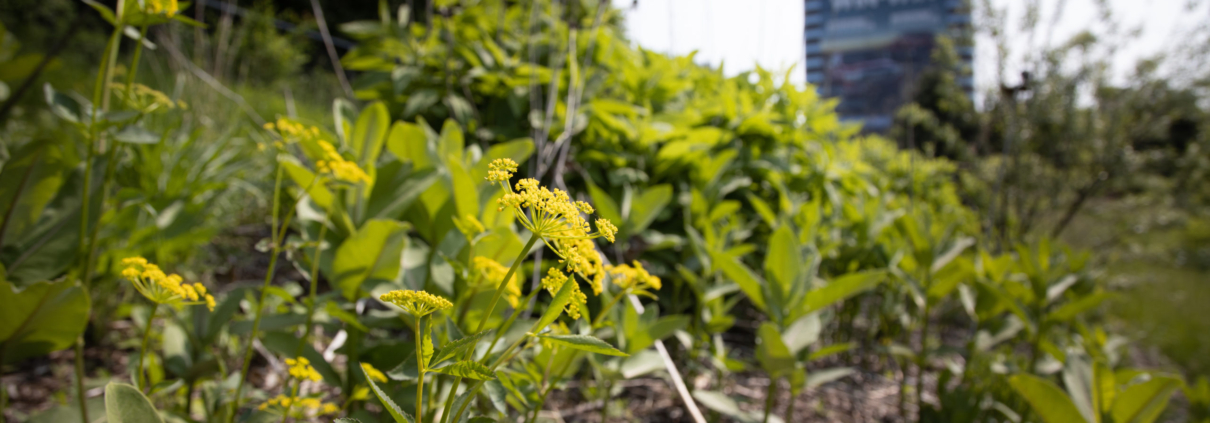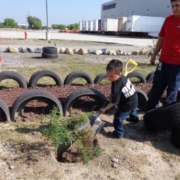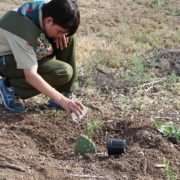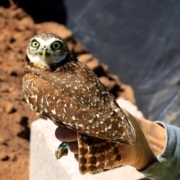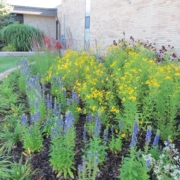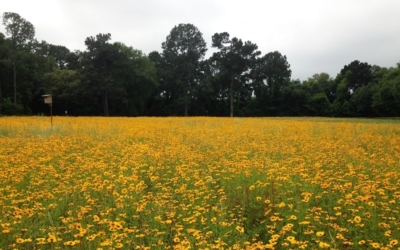Stellantis | Partners and Employees Create Habitat for Wetland Birds, Pollinators and More
The Stellantis US Headquarters and Technology Center, also known as the Auburn Hills Complex sits on a 550-acres corporate campus in Auburn Hills, Michigan. It serves as the North American headquarters for Stellantis, as well as its main research and development facility. The campus buildings and test track are surrounded by natural wetlands, stormwater ponds, upland and floodplain forest and landscaped areas.
Located in the wetlands is a heron rookery, where over 25 pairs of great blue herons have nested since 2006. Stellantis works to limit human disturbance of the nesting birds, as this might cause them to abandon their nests. Efforts are also taken to control and filter stormwater runoff that might enter the wetlands to protect water quality for the herons and their prey. The wetlands are also the location of a recently-installed wood duck nest box, as well as a beaver dam.
There are numerous pollinator gardens, including one that is a certified Monarch Waystation installed near one of the ponds. Stellantis also partnered with the on-campus First Nations Resource Group to install a garden near the main cafeteria that features culturally-important plants such as the three sisters (corn, beans and squash) and medicinal herbs.
Partnerships with local conservation organizations and schools help make this program as successful as it is. One of Stellantis’ strongest partnerships is with Avondale High School. Avondale students have participated in multiple projects over the years: they helped plant one of the pollinator gardens, they constructed bat houses, they built insect hotels (along with students from another school, Bowers Academy). The students also participated in a competition about reducing carbon, with the best projects presented at that year’s Earth Day event. In addition, every year Stellantis helps the students learn about stream ecology through the Stream Leaders stream monitoring program. David Jump, Environmental Health and Safety Specialist, understands how working with students like this is valuable for not only raising awareness of conservation issues, but encouraging an interest in STEM fields as well: “I want to be able to show these young people what STEM is, how cool it really is, and maybe give them a push to come into something like it.”
Other local organizations also contribute a great deal to the program and its success. The Oakland Audubon Society helps conduct bird and butterfly surveys several times a year, and leads employee “nature strolls” during the annual Earth Day event. Trout Unlimited also mapped an on-site creek connected to the wetlands and released juvenile trout to promote healthy fish populations.
In addition to Stellantis’ robust partnerships, employees have a strong enthusiasm for the projects that keeps the program going strong. Tonya Hunter, an Ecologist with contractor Environmental Consulting & Technology, remarked how Stellantis employees are “very enthusiastic about the wildlife and very passionate and excited” about the conservation projects. After participating in a trial use of EchoMeter Touch 2 acoustic bat detectors with WHC and local partners, a small group of employees even purchased their own bat detectors and survey the site for bats after hours a few times each year.
When it comes to successful conservation programs, a combination of strong partnerships and enthusiastic employees is a great approach to create long-lasting, positive outcomes.
Related Content
- White Papers:
- Relevant President’s Blog or Wildlife Blog posts
- What a Bat Monitor Can Teach Us About Inclusion
- A Hands-On Approach to Building the STEM Workforce of Tomorrow
- Let’s Go Outside! The Benefits of Learning in the Outdoors
- What We Learned by Building Insect Hotels
- Hands-On Means Minds-On
- The Importance of Pollinators
- New Ways to Think About Landscaping the Corporate Campus – A Conservation Conference Session Recap
- Going Native in Your Urban Garden
- Celebrate World Wetlands Day on February 2
- 10 Native Vines to Attract Butterflies in North America
- Back to School: Partnering with Local Schools to Strengthen Your Certification Program
- What’s All the Fuss About Native Plants?
- Celebrate Earth Day!
- Project Guidances:
- WHC Webinars:
- Beyond the Pollinator Garden: How to Make the Greatest Impacts for Bees and Butterflies
- Join the Earth Day 2020 Movement – It’s Not Too Late to Plan a Smaller-Scale, Yet Impactful Event
- How to Select the Best Lessons for Your Education Projects
- Native Bees: Bringing Essential Species Back to Your Habitat
- You Too Can Create Positive Pollinator Projects
- The Three “E”s to Success: Employees, Education and Engagement
- Build a Bug Palace – Learn How Easy, Inexpensive Insect Hotels Can Enhance Your Habitat
- Measuring the Success of Your Conservation Education Projects
- Event Planning 101: How to Host a Successful Community Event at Your Habitat
- We Need a Buffer: Protecting Wetlands by Installing and Monitoring Riparian Buffer Zones
- Taking Action Through Pollinator Projects
- STEM Learning in Your Habitat
- Plants and Pollinators with Dr. Stephen Buchmann
Quick Facts
| Site Name: | Stellantis - NA Headquarters and Technology Center |
|---|---|
| Category: | Member Spotlight |
| Tags: | avian, Awareness and Community Engagement, bats, landscaping, wetlands |
| Site Location: | Auburn Hills |
| Partners: | Avondale High School, Bright View Landscaping Services, Environmental Consulting & Technology, Inc. (ECT), Eurest Food Service, Oakland Audubon Society, Organization for Bat Conservation, Trout Unlimited |
| Certification Since: | 2013 |
| Certification Level: | Gold Certified |
| WHC Index Link: | Learn more about the program |
